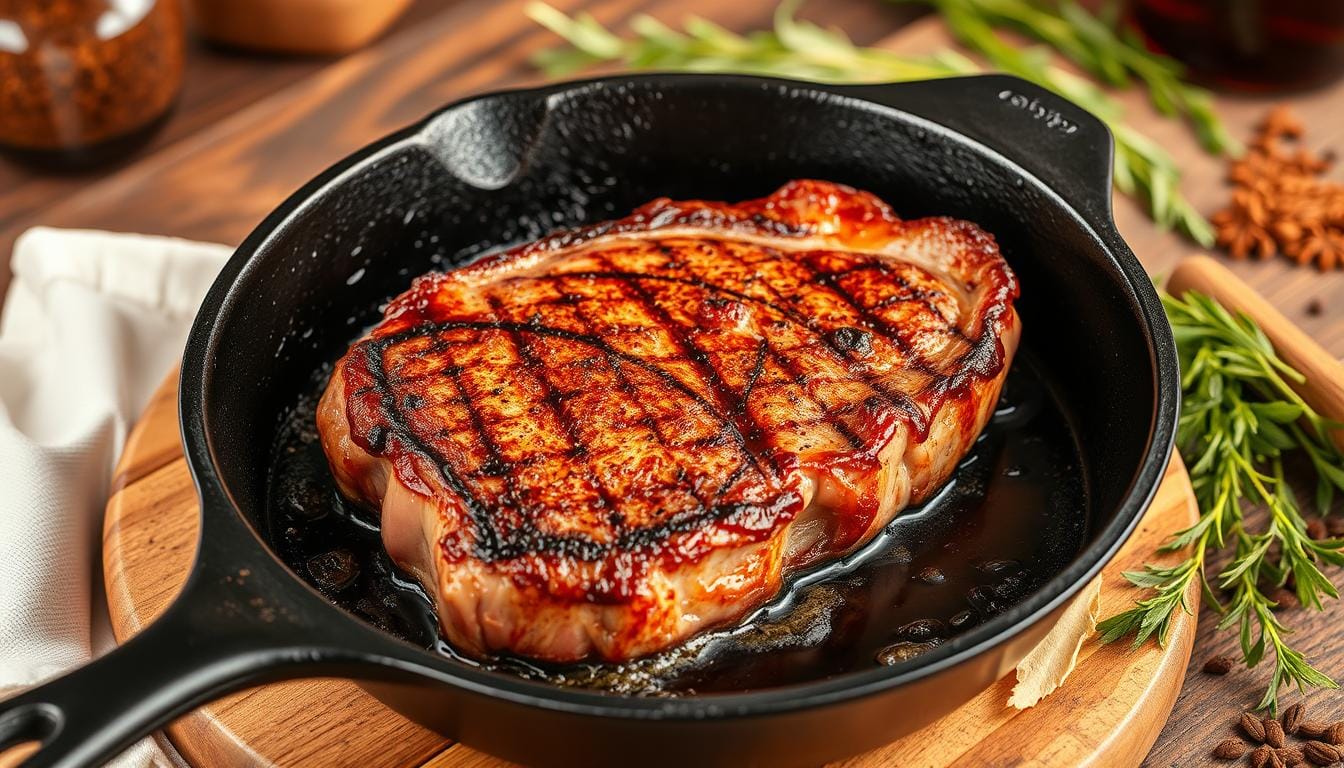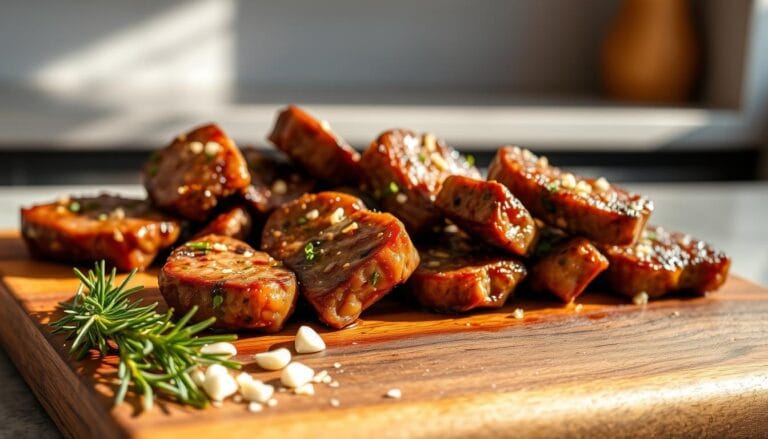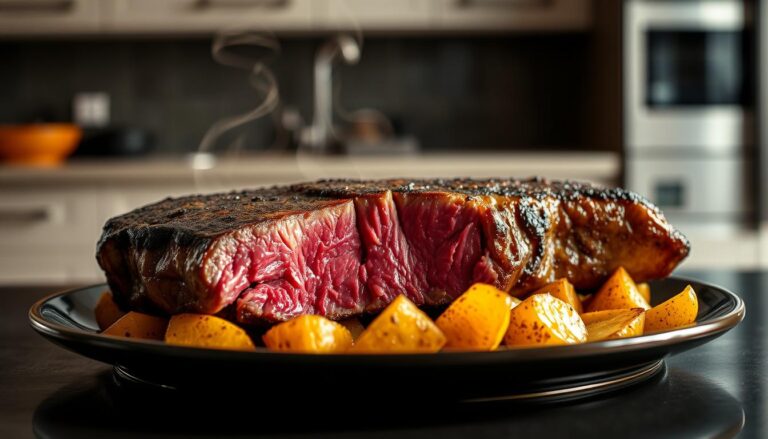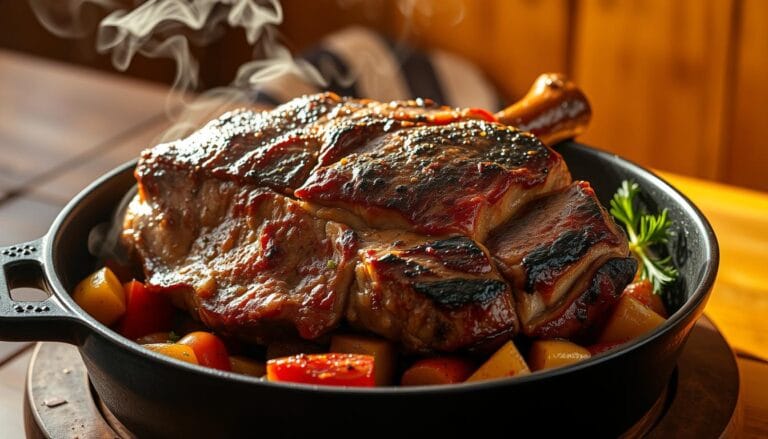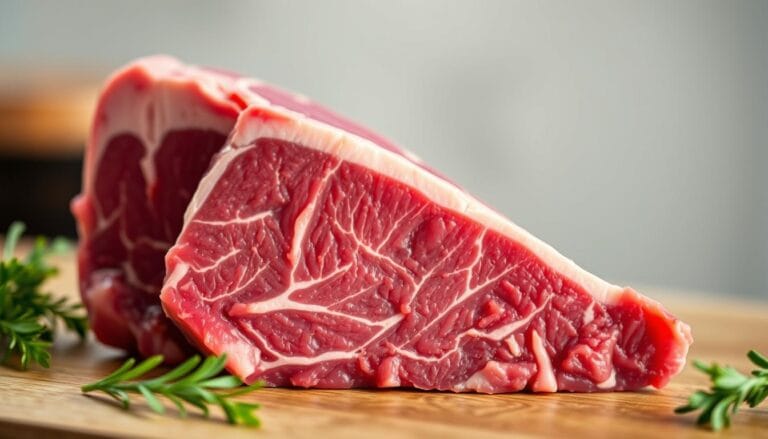Best Cast Iron Skillet Steak: Sear, Sizzle, and Total Satisfaction
Table of Contents
Best Cast Iron Skillet Steak: Sear, Sizzle, and Total Satisfaction
Cooking a steak in a cast iron skillet is special. The sizzle, the aroma, and the crust are all part of the magic. With the right techniques, you can make a top-notch steak at home.
To start, preheat your skillet over high heat. Then, add olive oil and butter for flavor. Searing your steak to perfection is the next step. For more tips, check out recipes like shrimp on steak.
Key Takeaways
- Preheat your cast iron skillet over high heat for optimal searing.
- Use a mix of olive oil and butter for added flavor.
- Sear your steak for 3-7 minutes per side, depending on desired doneness.
- Let your steak rest for 5-7 minutes after cooking to allow the juices to redistribute.
- Use a meat thermometer to ensure accurate internal temperatures.
Why Use a Cast Iron Skillet for Steak?
Choosing the right cookware is key to a perfect steak. Cast iron skillets stand out for their many benefits. They are perfect for both new cooks and experienced chefs.
Advantages of Cast Iron Cookware
Cast iron cookware is known for its durability and flexibility. You can use a cast iron skillet on stovetops, ovens, or even campfires. Chef John from Food Wishes calls it the most versatile cookware you’ll own.
“I’ve cooked steaks, roasted vegetables, and even baked desserts in mine.”
Heat Retention and Distribution
Cast iron skillets are great for steak because they retain and distribute heat well. They don’t have hot spots like thinner pans do. This means your steak cooks evenly, getting a perfect sear and staying juicy inside.
The heat retention of cast iron is famous. It’s a big reason why you can make a restaurant-quality pan-seared steak at home.
Versatility Beyond Just Steak
Cast iron skillets are not just for steak. They’re great for baking cornbread, making deep-dish pizzas, sautéing veggies, and searing chicken. They’re a valuable addition to your kitchen, replacing many other pans.
As you use your cast iron skillet more, it gets seasoned. This seasoning adds flavor to your food, making your cooking even better.
Choosing the Right Cast Iron Skillet
Choosing the right cast iron skillet is key to a perfect steak. The skillet you pick can greatly affect your steak’s taste and texture.
Size Matters: Which One to Pick?
A 10-12 inch skillet is perfect for most home cooks. It’s big enough for two steaks but easy to handle. For families, a 12-inch skillet is better. Solo cooks might like an 8-inch one.
The skillet’s weight is also important. Traditional cast iron is heavy, keeping heat well. Newer brands are lighter but work just as well.
Pre-seasoned vs. Unseasoned Skillets
Choosing between pre-seasoned and unseasoned skillets depends on your preference. Pre-seasoned skillets save time, but some like to season them themselves. Pre-seasoned skillets are easy to use, while unseasoned ones let you customize the seasoning.
Brands to Consider for Quality
Many brands are known for their quality. Lodge is famous for its value and American-made products. Stargazer has a smooth cooking surface, and Field Company offers vintage appeal with lighter weight.
Smithey is known for its beautiful skillets and even heat. Each brand has its own features and prices. Think about what’s most important to you.
Buying a quality cast iron skillet is a smart investment. With the right care, it can last for many years, making countless meals and memories.
Preparing Your Steak for Cooking
Getting your steak ready right is key for a tasty pan-fried meal. The steps you take before cooking can really make a difference.
Selecting the Best Cut of Steak
Choosing the right steak is the first step to a great pan-fried steak. Ribeye is known for its marbling, which makes it juicy and flavorful. New York strip is tender and has a rich beef taste. If you want tenderness, filet mignon is a good choice, but it’s less flavorful. Sirloin is another good pick, it’s tender and affordable.
The steak’s thickness is also important. Look for steaks that are 1-1.5 inches thick. This thickness helps you get a nice crust on the outside without overcooking the inside.
Bringing Your Steak to Room Temperature
Before cooking, let your steak come to room temperature. This takes 30-45 minutes and helps it cook evenly. Just take the steak out of the fridge and let it sit on the counter.
Essential Seasoning Techniques
Pat your steak dry with paper towels to remove excess moisture. This is important for a good sear. For seasoning, use kosher salt and freshly ground black pepper. Sprinkle these seasonings on 30-45 minutes before cooking to let the salt soak into the meat.
For extra flavor, try adding crushed garlic, fresh herbs like rosemary or thyme, or a light coat of neutral oil. These steps can make your steak taste like it’s from a restaurant.
Prepping Your Cast Iron Skillet
Getting your cast iron skillet ready is key when cooking strip steak on the stove. A well-prepped skillet gives you a perfect sear and better flavor.
Properly Seasoning Your Skillet
If your skillet is new or needs a refresh, start with a thin layer of neutral oil. Use vegetable or canola oil on the whole surface, inside and out. Then, bake it upside down in a 450°F oven for an hour. Let it cool completely in the oven afterward.
Do this 2-3 times for a new skillet to get a good seasoning. Proper seasoning is key for non-stick and to stop rust.
Preheating for Perfect Searing
To get a perfect sear, preheat your skillet well. This usually takes 5-10 minutes over medium-high heat. A hot skillet is essential; test it by flicking water drops onto it. They should dance and evaporate right away. This means your skillet is ready to cook.
Using Oil: What to Choose?
For cooking oils, pick ones with high smoke points. Avocado oil (500°F), refined grapeseed oil (420°F), or clarified butter/ghee (450°F) are great. They can handle high heat without burning.
For extra flavor, use butter in the last few minutes of cooking. But start with a high smoke point oil for that perfect crust. You only need a thin layer of oil to coat the bottom of the pan. This helps the meat make good contact with the hot surface, not to fry.
By following these steps, you’ll cook a perfect strip steak on your stove with a cast iron skillet. Remember, the secret to a great steak is in how you prepare both the steak and the skillet.
Cooking Techniques for Steak
To get the best cast iron skillet steak, you need to know the right cooking methods. Cooking steak right means searing, basting, and checking if it’s done.
Searing Your Steak: The Right Method
First, heat your skillet well. Then, put your steak in the middle and press it down. This helps it get in full contact with the hot surface. Don’t move the steak for 3-4 minutes to let the Maillard reaction create a nice crust.
Flip the steak only once, unless it’s very thick. Thicker steaks might need flipping more to cook evenly.
For steaks over 1.5 inches, try the reverse sear method. Cook it in a 275°F oven until it’s 15°F below your target. Then, sear it quickly in the hot skillet.
Basting for Extra Flavor
Basting makes your steak taste like it’s from a restaurant. In the last 1-2 minutes, add butter, garlic, and herbs to the pan. Tilt the skillet and pour the flavored butter over the steak. This adds flavor and richness.
Checking Doneness: Using a Thermometer
A good instant-read thermometer is key for perfect doneness. Use it for: 120-125°F for rare, 130-135°F for medium-rare, 140-145°F for medium, 150-155°F for medium-well, and 160°F+ for well-done. Remember, the steak will cook a bit more after you take it out of the heat, so adjust your target temperature.
Finishing Touches After Cooking
Once your steak is cooked, the real magic happens in the finishing touches. These final steps can transform a good pan-seared steak into an exceptional dining experience.
Resting Your Steak for Optimal Juiciness
Resting your steak is a key step. It allows the juices to spread evenly, making it juicy and tender. For most steaks, a 5-10 minute rest is enough. Larger cuts might need up to 15 minutes. To keep some heat, loosely cover the steak with foil.
Proper resting is key to maintaining the quality of your pan-seared steak. This simple step makes a significant difference in the overall dining experience.
Creating a Pan Sauce from Drippings
While your steak rests, use the flavorful drippings to make a quick pan sauce. Start by deglazing the skillet with wine, bourbon, or beef stock. Scrape up the browned bits with a wooden spoon. Add minced shallots or garlic for extra flavor, then reduce the mixture slightly. Finish it with a pat of cold butter for richness and sheen. You can also add herbs like thyme or rosemary to enhance the sauce’s aroma.
Using the drippings to create a pan sauce not only adds flavor but also elevates the presentation of your dish.
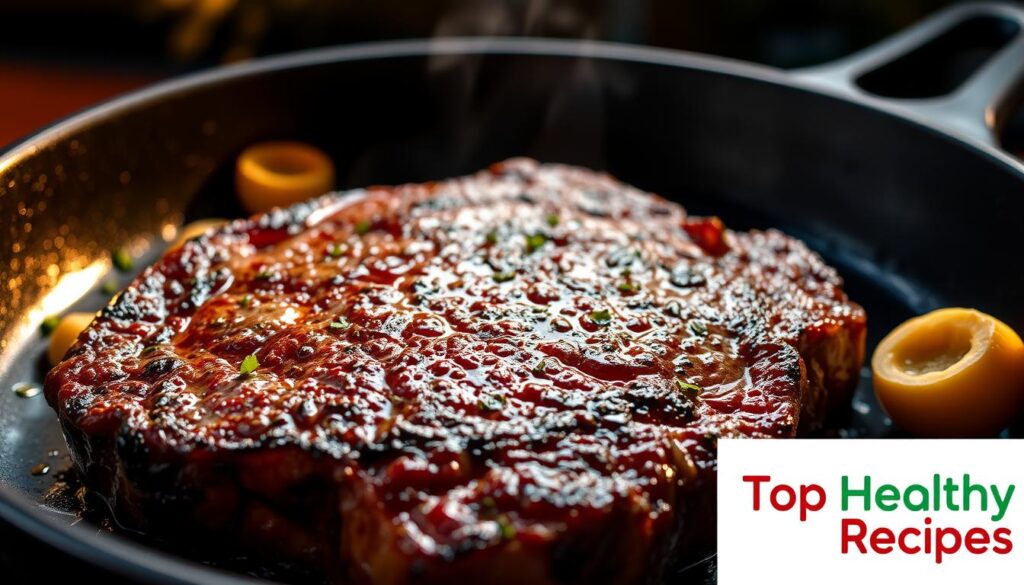
Slicing Techniques for Presentation
When slicing your steak, cut against the grain for tenderness. Identify the muscle fibers and cut perpendicular to them. For a better look, slice at a slight angle, creating wider pieces. A sharp knife is key to avoid tearing the meat and losing juices. For strip steaks and ribeyes, slices about ¼-inch thick show off the beautiful pink interior while keeping the meat warm.
Slicing your steak correctly is the final touch that elevates your home-cooked meal to steakhouse quality.
Common Mistakes to Avoid
Cooking a perfect steak on a cast iron skillet is more than just a recipe. It’s about avoiding common mistakes. When you learn how to cook a steak on the stove, knowing these mistakes can make a big difference. It will improve your cooking and the taste of your steak.
Overcrowding the Skillet
One big mistake is putting too many steaks in the skillet. When steaks are too close, they steam instead of sear. This makes the steak gray and unappetizing. To fix this, leave at least an inch between steaks. Cook in batches if you need to.
Neglecting Temperature Control
Temperature control is key. If the skillet isn’t hot enough, steaks cook too long and get overcooked. On the other hand, too much heat can burn the outside before the inside is cooked. To get it right, use an infrared thermometer to check your skillet’s temperature. Aim for 400-450°F and adjust the heat as needed.
Skipping the Resting Period
Not letting the steak rest is a big mistake. Cutting into it right away lets the juices spill out. This makes the steak dry. Even a few minutes of patience can make a big difference, even for bigger steaks.
- Always leave space between steaks to avoid steaming.
- Monitor and adjust the skillet’s temperature.
- Allow the steak to rest before serving.
Cleaning and Maintaining Your Skillet
To keep your cast iron skillet perfect for cooking steaks, regular care is essential. A well-kept skillet cooks better and lasts longer. This means more delicious meals for you.
Proper Cleaning Techniques
Let your skillet cool a bit before cleaning. Cleaning it while warm makes it easier. Mild soap is okay for cleaning; it won’t hurt the seasoning.
Use hot water and a stiff brush or chain mail scrubber to clean. For tough spots, add coarse salt or simmer water to loosen food.
Cleaning Tips:
- Avoid harsh scouring pads to protect the seasoning.
- Use a stiff brush or chain mail scrubber for cleaning.
- For tough spots, try coarse salt or simmering water.
Avoiding Rust: Best Practices
After cleaning, dry your skillet well. First, use a clean towel, then heat it over low heat for a few minutes. This step is key to avoiding rust.
| Action | Purpose |
|---|---|
| Dry with a clean towel | Remove excess moisture |
| Place over low heat | Evaporate remaining moisture |
| Apply a thin layer of neutral oil | Maintain seasoning and prevent rust |
How to Re-season Your Skillet
If rust appears, don’t worry. Just scrub it off with steel wool, wash, dry, and re-season. For re-seasoning, apply oil, wipe off excess, and bake upside down at 450°F for an hour. Do this 2-3 times to build a strong seasoning layer.
By following these steps, you’ll keep your cast iron skillet in top shape. It will be ready for cooking your favorite pan-fried steaks.
Pairing Side Dishes with Steak
Make your steak dinner even better with the right sides. After learning how to cook strip steak on stove, pick sides that match its flavor.
Classic Sides that Complement Steak
Traditional steakhouse sides are loved for a good reason. Creamy mashed potatoes are soft and soak up juices. Roasted asparagus or green beans add freshness. A simple wedge salad with blue cheese dressing brings coolness and tanginess.
- Mashed potatoes with garlic and rosemary
- Roasted vegetables like asparagus or Brussels sprouts
- Wedge salad with blue cheese dressing
Innovative Pairing Ideas
Try new sides for a twist. Roasted bone marrow is rich and indulgent. Crispy smashed potatoes with herbs add texture. Grilled radicchio with balsamic glaze brings a sweet-bitter taste. Mushroom dishes, like sautéed with garlic and thyme, add depth.
- Roasted bone marrow for a luxurious treat
- Crispy smashed potatoes with rosemary and garlic
- Grilled radicchio with balsamic glaze
Wine and Beverage Suggestions
Red wine is the top choice for steak. Different cuts go with different wines. Ribeye pairs well with bold Cabernet Sauvignon or Syrah. Leaner steaks match medium-bodied Merlot or Sangiovese.
For those who don’t drink wine, craft beer is a great option. Amber ales or porters go with fatty cuts. Lean steaks pair with crisp pilsners.
Bourbon or rye whiskey can also be a sophisticated choice. Serve them neat or with a single ice cube. Sparkling water with citrus or cold-brewed coffee can also enhance your steak experience.
Cooking for Different Preferences
Cooking with a cast iron skillet lets you tailor your steak to anyone’s taste. It’s perfect for both steak enthusiasts and those with special dietary needs. The skillet’s versatility makes it a great choice.
Adjusting Cooking Times for Different Doneness
To get the perfect steak, adjust cooking times based on your liking. For a rare steak (120-125°F), sear each side for 3-4 minutes for a 1-inch steak. For medium-rare (130-135°F), cook for 4-5 minutes per side.
Medium (140-145°F) steaks need 5-6 minutes per side. Using a thermometer ensures you don’t overcook it.
For well-done steaks, try the reverse sear method. Cook the steak in a 275°F oven until it’s 10°F below your target. Then, sear it quickly to add a crust. This method prevents burning and ensures it’s cooked through.
Customizing Seasonings for Different Tastes
Seasoning preferences vary widely. Some like simple salt and pepper, while others prefer bold flavors. A coffee-based rub can add a rich taste to your steak. A chimichurri-style herb blend brings a fresh flavor.
For a spicy kick, use a blackened seasoning with paprika, cayenne, and herbs. Experiment with different seasonings to find your favorite.
Cooking for Dietary Restrictions
When cooking for guests with dietary restrictions, consider a few things. For low-sodium diets, use acid and herbs for flavor instead of salt. For paleo or keto diets, choose high-quality meat and cook with clarified butter or avocado oil.
For leaner options, pick sirloin or filet mignon and use minimal fat. Cooking a larger cut allows you to slice it to different thicknesses. This way, you can please everyone with a single piece of meat.
By adjusting to different preferences and dietary needs, you can make a memorable best cast iron skillet steak experience for all.
The Health Benefits of Steak
Pan-seared steak is not just tasty; it’s also good for you. It’s full of protein, which helps your muscles grow and stay strong. A 6-ounce serving has about 40-50 grams of protein.
Nutritional Value of Steak Cuts
Steak cuts have different nutritional values. Ribeye and strip steaks have more fat, including good fats, but more calories too. Leaner cuts like sirloin, top round, or filet mignon have lots of protein and less fat.
Nutritional Comparison of Steak Cuts
| Steak Cut | Protein Content (g) | Fat Content (g) | Calories |
|---|---|---|---|
| Ribeye | 40 | 30 | 420 |
| Sirloin | 45 | 15 | 320 |
| Filet Mignon | 42 | 10 | 280 |
How Cooking Methods Affect Health
How you cook steak changes its health benefits. Pan searing keeps nutrients and adds flavor. It’s better than deep frying or heavy breading, which add extra calories and fats.
Grass-fed beef has more omega-3s and CLA, which may fight inflammation. But it’s pricier than grain-fed beef.
Lean Cuts and Their Benefits
Lean cuts like eye of round and sirloin tip are good for those watching fat. They have lots of protein and less fat, making them a healthier choice if cooked right.
To enjoy steak healthily, eat it in moderation with lots of veggies. Limit it to a few times a week. This way, you get steak’s benefits without overdoing it.
Real-life Cooking Experiences
Learning to cook steak on the stove is a journey of trial and error. Home cooks keep trying new things to get better. They find new ways to make their cooking better.
Success Stories from Home Cooks
Many home cooks have improved their steak-cooking skills. They did it by being persistent and using the right techniques. For example, Michael from Denver says, “A good instant-read thermometer changed the game. Now, my family loves my ribeyes more than going out.”
“The game-changer was investing in a good instant-read thermometer and trusting it over timing.”
Rebecca from Chicago found a secret. She preheats her cast iron skillet well and doesn’t move the steak too much. This makes a perfect crust.
Tips from Professional Chefs
Professional chefs share tips that can make home cooking better. Chef James Briscione recommends flipping steaks often for thicker cuts. This can cut cooking time by about 30%. Chef Amanda Freitag says to listen to the steak while it’s cooking. A steady sizzle means the heat is just right.
- Flip steaks every 30 seconds for more even cooking.
- Listen to the steak sizzling to gauge the heat.
- Use a thermometer to ensure the right internal temperature.
Testimonials on Cooking with Cast Iron
Cast iron fans often see big improvements in their cooking. Tom from Seattle credits his grandmother’s cast iron skillet for his steakhouse-quality steaks at home.
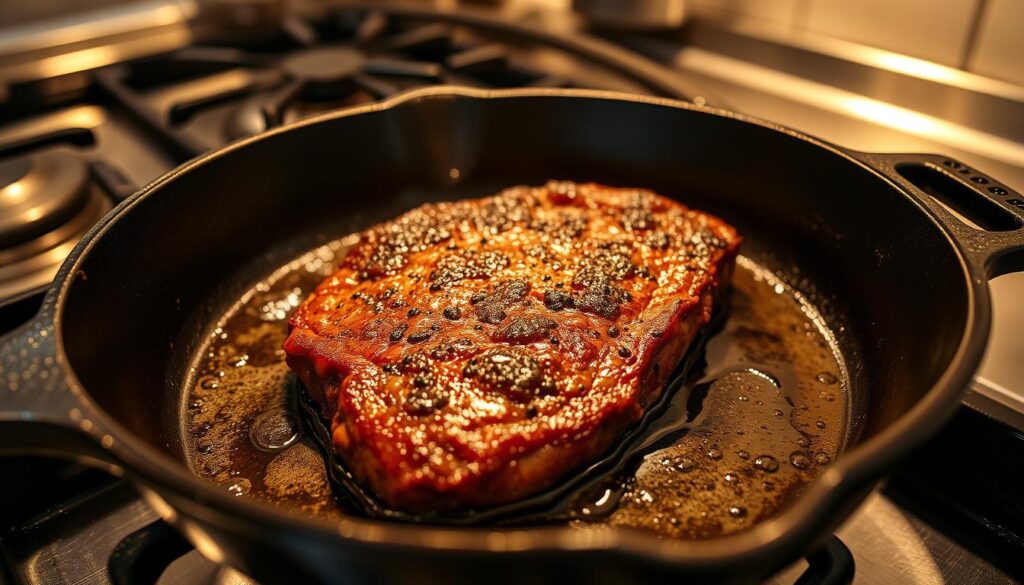
Sarah Jenkins, a professional baker, loves cast iron. She says its heat retention makes cooking consistent.
| Cooking Method | Heat Retention | Ease of Use |
|---|---|---|
| Cast Iron | High | Moderate |
| Non-Stick | Low | Easy |
| Stainless Steel | Medium | Moderate |
Summary of Key Takeaways
Cooking a perfect pan fried steak can make your home cooking better. By following the tips in this article, you can make a steakhouse-quality meal at home.
Essential Techniques for a Perfect Steak
To cook a perfect pan fried steak, start with a thick, well-marbled steak. Let it come to room temperature, pat it dry, and season it well. Preheat your cast iron skillet before searing the steak at the right temperature.
Use a meat thermometer to check if the steak is cooked right. Let it rest before slicing.
Experimenting with Flavor and Technique
Cooking steak at home lets you customize it to your liking. Try different seasonings, like compound butters with herbs and garlic. Or, use different finishing salts.
Adjust the searing temperature and cooking time to your taste.
Enjoying the Fruits of Your Labor
Cooking steak is more than just the end result. It’s about the process too. Enjoy the sizzle, the aroma, and the pride of serving a perfectly cooked steak.
With practice and patience, you’ll get better at making pan fried steak.
FAQ
What is the best cast iron skillet size for cooking steak?
How do I properly preheat my cast iron skillet for searing steak?
What type of oil should I use for cooking steak in a cast iron skillet?
How often should I flip my steak while cooking it in a cast iron skillet?
How do I achieve the perfect doneness for my steak?
How should I rest my steak after cooking?
How do I clean and maintain my cast iron skillet after cooking steak?
Can I cook steak in a cast iron skillet if I have dietary restrictions?
What are some good side dishes to pair with steak cooked in a cast iron skillet?
How can I make a pan sauce using the drippings from my steak?
For more cooking tips, stay connected with us. We also recommend the cookbook Skinnytaste Simple: Easy, Healthy Recipes with 7 Ingredients or Fewer
For more Recipes about Steak ?
Did You try our recipe ?
There are no reviews yet. Be the first one to write one.
